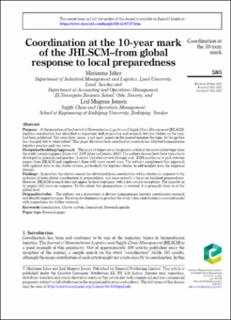Coordination at the 10-year mark of the JHLSCM–from global response to local preparedness
Peer reviewed, Journal article
Published version
Permanent lenke
https://hdl.handle.net/11250/2983437Utgivelsesdato
2021Metadata
Vis full innførselSamlinger
- Scientific articles [2181]
Originalversjon
Journal of Humanitarian Logistics and Supply Chain Management. 2021, 11 (4), . 10.1108/JHLSCM-06-2021-0051Sammendrag
Purpose At the inception of the Journal of Humanitarian Logistics and Supply Chain Management (JHLSCM), logistics coordination was identified as important, both in practice and research, but few studies on the topic had been published. Ten years later, many, if not most, papers in the journal mention the topic. So the picture has changed, but to what extent? This paper discusses how coordination research has followed humanitarian logistics practice and vice versa. Design/methodology/approach The point of departure in the present article is the most salient topic from the study’s original papers (Jahre et al., 2009; Jahre and Jensen, 2010). The authors discuss how these topics have developed in research and practice. A recent literature review (Grange et al., 2020) enables us to pick relevant papers from JHLSCM and supplement them with more recent ones. The authors complement this approach with updated data on the cluster system, particularly the logistics cluster, to add insights from the empirical domain. Findings In practice, the cluster concept has developed from coordination within clusters in response to the inclusion of inter-cluster coordination in preparedness, and more recently a focus on localized preparedness. However, JHLSCM research does not appear to have kept pace, with a few notable exceptions. The majority of its papers still focus on response. To the extent that preparedness is covered, it is primarily done so at the global level. Originality/value The authors use a framework to discuss humanitarian logistics coordination research and identify important gaps. Based on developments in practice, the study’s key contribution is a revised model with suggestions for further research.

